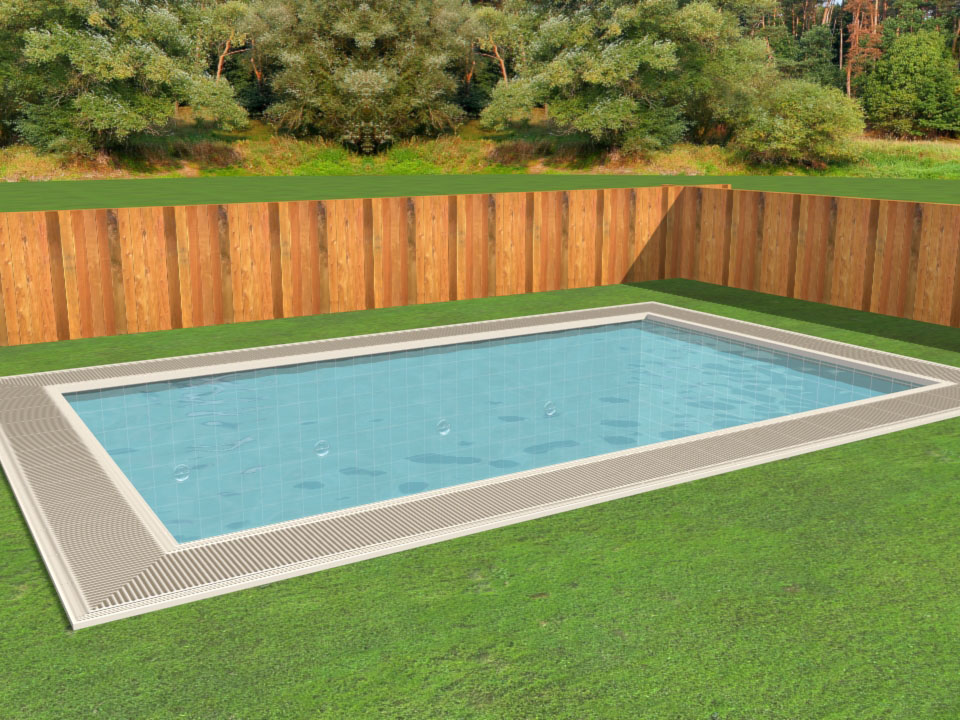A swimming pool can be defined as container, which has been filled with water for the intention of swimming or other water-based recreation activities. Some may refer to it as a wading pool, while others prefer a swimming bath. It can also be just called a pool. Pools exist in many standard sizes; the deepest and largest being those used in Olympic games.
Pools can be built above or in the ground. Materials needed include concrete (also known as gunite), plastic, metal, or fiberglass, vinyl, polymer, steel and plaster. Swimming pool construction prices may range from $17 to $39. This depends on the kind of materials used. It is crucial to mention that these prices do not include other costs like building decks, putting up fences, heaters, and other personalized modifications. The advance of a composite construction of fibreglass, which has an epoxy coating with porcelain-ceramic tiles, has given rise to the modern types with major advantages over past methods (Swimming pool.com N. p).
Public pools are used by many people or by the public, while those used solely by a few people or in a private home are referred to as private. Public pools are to be found in fitness centers, health club, and many private clubs. These are mostly for relaxation and exercises. It is important to mention hot tubs and spas. These are pools in homes, clubs, hotels and massage parlors containing hot water and either used for relaxation or therapy. Water sports such as diving can also be done in swimming pools including the training of astronauts and lifeguards (NASA N. p). To save on expenditure, one may wisely decide to oversee the construction of his/her dream swimming pool instead of buying a readymade one. Below is a process of how to build a swimming pool, whether private or public, from the scratch.
Choosing a Place for the Swimming Pool
The south side of the lawn is ideally recommended. The area should be near to water and electricity connections and away from trees (Beegel, Shillinglaw and Tiffney 21). However, to give the swimming pool enough space, one must not only consider adjusting to the surroundings but also compromise with the pool construction. In my case, I have decided to put the washbasin in a slope below, to prevent it from being bulky behind my house. This is purely for aesthetic reasons for it will not behold a beautiful site if the roofing of the pool prevents the view of the rest of my lawn. In addition, dark green roofing (or any dark color you prefer) would be preffered so as to avoid the roof being excessively striking to the eye (Krammer, 1).
In designing the swimming pool, we should also consider the wash basin. Various types exist; for instance, the steel wash basins, polyester washbasins, iso-stones, concrete pool completely from formwork, and swimming pool with scarf stones (Krammer, 1). A choice depends on the price, the easiness of construction and how good the finish is preferred. I settle on scarf stones for my pool construction because it is relatively cheap (50×20×23v costs 1.10$). In addition, it saves concrete.
Pool Size
The size is decided upon by practical terms. For example, my foil width l is 2.10, which is a bit narrow for a pool. It has 4.05 pools, which is an interior measure. Because it will need roofing, this should be concise with the outer wall. For my case, it has 4.50 meters outside. This fits perfectly. The outer-rail is 21 cm.
Designs of the Length of the In- ground Pool
One should ensure that the length of end walls and the roofing on the pool walls end. As a result, one can drive the roofing above the technology shaft. Given the front end can be removed or opened, it is rather good. I choose to leave out half of the patio, so that through wintry weather, no differences in colour on the terrace can appear (Sahatchai, N.p).
Swimming Pool’s Technology Shaft
Lengthwise measurement for the technology shaft in the pool should arise from the pool width. I have decided to fix 1.50 meters as my inside measure. This should be able to move in it. Furthermore, the technology space is put nearly 50 cm deeper for one to be able to reach it directly.
Stair in the Swimming Pool
For my design, I decided to put concreted roman steps in the swimming pool. This is because it looks better than only one entrance leader and that one can sit on it comfortably. Also, this can again be realised with scarf stones. The roofing dictates that the stairs will be inside.
Planning and Preparation for the Base Plate in the Pool
For pipe dimensions with the pool construction, I decided on DA 63 for all the inlets and derivatives. Inlets up to the first piece are DA 63, and then continued with DA 50. Because I want to hold my inlet to the installation parts as curtly as possible, all tubes will run by the base plate. I also have four nozzles for ground finish and two others for wall finish for the surface cleaning.
Installation Parts in the In-ground Swimming Pool
These are 4x ground finish, 2x finish nozzles in the Roman stair, 1x ground expiry in the pool2x Skimmer (including 20 cm of neck for technology shaft) and 2x underwater floodlight, which is a must have.
Creating the Base plate for the pool
To ensure strength of the base plate you can use a 25 cm drainpipe and a 15 cm steel mat. This is okay in lowlands with serene climate. A rough rule of the thumb is that a good base plate should be 50 cm. Given the swimming-pool will be filled with water (in winter). The draining is to be laid out more thinly. For that matter, I have a frost casing of approximately. This is plus 20 cm of concrete, in addition to two positions of Q80 of steel mats.
Marking out the Base Plate Pool
To get a precise picture, one marks the base plate before looking at it from a distance. If it is seen that everything fits, one should mark half a meter around the base plate in order to allow working in the pit. The calculations of the depth of my swimming pool are 20-30 cm (from the ground). These should be able to resist rainwater.
The Pool Base Plate Excavation
After accurate levelling, the bottom is then dug up with an excavator. The technology shaft will be dug 50 cm before, and 50 cm of step deeper. A shaft from the house to the swimming pool will be laid with a light slope so as to empty the tubes during winter.
Technology Shaft Shutter
The technology shaft to the pool should be 50 cm deep. It should ensure that one is able to stand upright. In my case, in the 100th pipe I will lay the tube for nozzles. This will ensure they remain movable when the valves are to be exchanged later.
Putting the Base Plate Concrete
One will need approximately 11.5 ms ³ concrete for the base plate. Thus, two Truck loads are sufficient. The process to concrete the step together with the technology shaft involves filling only the step with the concrete, followed by concreting the base plate on top. Then allow the concrete to condense. Later, smooth it with a balance mass. From excavation to the last step it can last an average of 2 ½ days.
Building Pool Walls
The pool walls are preferably bricked with scarf stones. This also includes walls at the technique pit. Then reinforcing steel bars into every scarf stone rows are put. Let us now look at some special fittings for the swimming pool.
Installation of Swimming Pool Accessory
Insert the skimmer into the walls of the pool in order for water to be partly discharged (in the winter). The Skimmer will be concreted with borders of 4cm into the pool. The revision cover will precisely match with the edge (U.S Department of Energy, N.p). A counter current plant and intake nozzles will lie above the water. This plant should be put 30 cm under water to ensure that, in winter, the water level will not sink the headlights. Underwater headlights should be put 10 cm underwater taking into consideration possible ice. The headlights will be in-peeled 4cm into the pool. The distributor box will stand in the water. The box will be concreted above the pond edge.
Conclusion
The above discussion is an elaborate description of how to build a swimming pool from the scratch. Following these steps will give one his/her dream swimming poll. It is important to mention that one should also consider using alternative local materials to minimise costs. In addition, one should consult the local authorities for any available regulations on swimming pool construction. Some jargon used in this discussion may scare off a beginner, but just a slight interest and effort will enable one to build a swimming pool.


